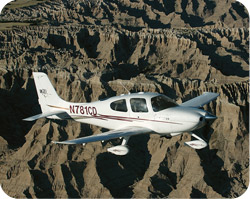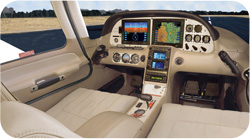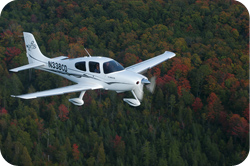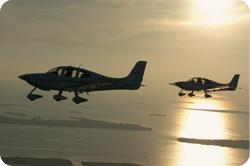| |
|
|
|
| |
THE SPIN KING: Interview with Rich Stowell
 NAFI Master Instructor Rich Stowell is a noted authority on spin
training, having experienced more than 25,500 spins during dual
instruction – the equivalent of over 1,200 vertical miles
traveled while spinning. NAFI Master Instructor Rich Stowell is a noted authority on spin
training, having experienced more than 25,500 spins during dual
instruction – the equivalent of over 1,200 vertical miles
traveled while spinning.
Stowell says that it’s poor recognition of the situations
and variables that get pilots into stalls, that invariably to a
stall departure and into an inadvertent spin, and that sadly, there
are still way too many stall/spin accidents occurring in General
Aviation.
Reviewing the FAA accident data over a twenty-five year period
from 1972 through 1997, a disturbing trend is evident: 93% of stall/spin
accidents occur at or below traffic pattern altitude – an
altitude where successful recovery is not likely, and in many cases
impossible. With those facts and additional research in mind, Cirrus Design became interested in preventing the stall/spin scenario
for its pilots, and incorporated unique design features into the
CIRRUS wing to aid in spin prevention.
Stowell says that because no single airplane can be all things
to all pilots - there have to be compromises. "A Pitts and
a Boeing 777 don't have anything in common, except that they're
both airplanes. That doesn't mean that one is 'better' than the
other, it just means that neither will fulfill all desires to all
pilots. How that mentality applies to CIRRUS aircraft is that it
sometimes seems there are a few folks that feel the CIRRUS could
be an even 'better' plane if it could be approved for spins. But
of course, all single engine aircraft operating in the normal category
have that limitation, and that's a lot of planes."
Stowell explained, “There are more than 100 variables that
go into different equations for spin dynamics, spin motion, and
spin recovery. Just because a certain recovery input worked once,
doesn't mean it will work again - because it can almost never be
exactly duplicated. What can be so dangerous about spins is that
even though a recovery procedure worked on Tuesday, it doesn't
mean you're guaranteed to have it work on Wednesday. It might be
something as seemingly insignificant as a single gallon more of
fuel on board, but that 'snapshot' of it making a recovery in one
scenario really means nothing about its overall ability to be a
safe spinning airplane.”
 "NASA found,” added Stowell, “that the difference
between recoverable and unrecoverable spins could literally be
traced down to the machining level of the wing root fairing! This
is how minute the subtle sensitivities are that airplanes can be
susceptible to." "NASA found,” added Stowell, “that the difference
between recoverable and unrecoverable spins could literally be
traced down to the machining level of the wing root fairing! This
is how minute the subtle sensitivities are that airplanes can be
susceptible to."
When asked about why many airshow pilots still
utilize a spin sequence in their show routines, Stowell said, "If
you look at the higher-end airshow pilots - with a couple of exceptions,
and of course it partially depends
on the plane - but only a few spin precariously close to the ground. Most
start their routine with a spin series to lose altitude and get down to what
they call show altitude.”
We've all heard stories about panicked flight students - even
during regular primary training - occasionally freezing on the
controls and jeopardizing the safety of both themselves and their
instructor. Stowell said he's been fortunate to have had only two
students freeze on the controls, but that oddly the two had vastly
different flight time and experience, an indication that outward
appearance and demeanor are never foolproof when it comes to determining
who will panic and who won't.
"One was a low-time private pilot, and we were doing routine
upright spins in a Decathlon. Rather than try and wrestle the controls
away from him - leaving him terrified of any future spins, not
to mention embarrassed - I was able to verbally talk him through
the recovery. The other person that froze on the controls with
me was an air force test pilot, was while we were conducting inverted
flat spins. That's a substantial range of experience between the
two, but most pilots no matter how much total time don't have a
lot of spin experience. In the second case, I was able to 'snap'
him out of his momentary freeze and again talk him through it.
If I don't have to physically intervene, that's the best outcome."
When it comes to planes behaving badly, Stowell says he's had
very few 'surprises,' and credits that to his reluctance to ever
push a plane past its limits. "First," says Stowell, "I'm
not a test pilot, and if a plane I'm flying is placarded against
spins, then I don't attempt them. All of the planes I spin have
to be approved for intentional spins - no exceptions, no pushing
the envelope because I'm an 'expert.'
For most pilots, Stowell says that spins are like wine. They
may seem to 'taste' the same, but after enough of them, you learn
the subtleties. "There are nuances among planes, or even in
the same plane under different conditions. If I’m flying
a different airplane type than I’m used to, it can take awhile
to discover it’s unique ‘character’, but I can’t
recall any circumstances of ever being truly surprised at the behavior
or recovery style of a plane in a spin." Stowell added that
with a thorough understanding of spin dynamics, you learn to expect
different types of behavior of for example, incipient versus developed
spin characteristics.
"There's a tendency for a lot of low wing planes to oscillate
in an upright spin, but high winged planes don't tend to do that.
However, put a high wing plane into an inverted spin and it will
tend to oscillate because in that situation its become a 'low'
wing, so to speak." In terms of how many spins should be practiced
with an instructor, Stowell says, "From a training standpoint,
I find it better to do ten one-turn spins than one ten-turn spin.
Most students have a finite number of rotations before they're
'spent' and ten one-turn spins is repetitive and it sticks with
them, i.e., the control recovery inputs become a habit. As with
any training, the learning is in the repetition.
STOWELL on CIRRUS
 Stowell is a firm believer that the only reason a plane ever spins is because
a pilot is at the controls. "A pilot either has to get really distracted,
or be trying to really force a plane into something it inherently doesn't
want to do if he finds himself in an inadvertent spin. There's only one
reason an airplane spins and that's because there's a pilot touching the
controls! You could actually bail out of a plane and it might oscillate
on its own, perform some fugoids, and eventually spiral, but it would never
spin. A spin requires the accidental or intentional inputs of a pilot." Stowell is a firm believer that the only reason a plane ever spins is because
a pilot is at the controls. "A pilot either has to get really distracted,
or be trying to really force a plane into something it inherently doesn't
want to do if he finds himself in an inadvertent spin. There's only one
reason an airplane spins and that's because there's a pilot touching the
controls! You could actually bail out of a plane and it might oscillate
on its own, perform some fugoids, and eventually spiral, but it would never
spin. A spin requires the accidental or intentional inputs of a pilot."
Asked specifically about CIRRUS aircraft, Stowell is equally
adamant. "CIRRUS is designed so that you either have to be
asleep at the wheel, or actually force the airplane to get into
a spin. Take for example a high-performance Pitts biplane - with
just a bit of coaxing it will actually spin quickly and easily.
With a CIRRUS you have to work quite hard to override the safety
features built into the design to force it into a stall and spin
scenario.”
What a student can expect when he goes to Stowell for spin training,
is that they will build gradually from performing simple, straight-forward,
power-off and straight ahead stalls with a controlled spin entry
and recovery within one turn. On the next lesson, Stowell says
most students progress to aggravated spin entries, meaning they’ll
enter spins normally and then ‘play with the power settings’ to
see its effect and also deflect the ailerons to see it’s
effect on recoveries. Eventually they’ll work up to increasing
the elevator movements and noting the effects on entry and recovery. "For
the aggravated spin demos, we’ll typically do two-four turns
per spin" says Stowell.
In addition to normal spin training, Stowell likes to put his students through
unusual attitude recoveries from various spins. "I’ll put them
into the spin from any attitude and any speed and then yell, ‘recover.’ The
caveat is that I help them to not panic by instructing them to not make any
control input or do anything at all unless they simultaneously yell out loud
what action they’re taking." Stowell says he uses this unique
method to get pilots to keep their brain engaged and in control of what their
body is experiencing. "It forces discipline," says Stowell, "and
in any emergency I tell them that taking no action is better than panicking,
over-reacting, and doing the wrong thing."
Stowell likes to make the unusual attitude recoveries ‘interesting’ and
says, "we don’t do the bread and butter power off and wings level
scenarios. I prefer to make aggravated and accelerated spin entries because
in real life that’s what gets pilots into trouble. For this lesson
we might be climbing and turning, with the flight controls out of position,
so that when you go into the spin it's what we call and 'over the top' entry.
Even though it's not required, I make sure we wear parachutes for this, as
it's always good to have a back-up."
 Interestingly, Stowell says that while once researching the reasons pilots
bailed out over an eighteen-year stretch he was surprised to find that spins
were number three or four down the list with jammed controls taking the top
spot. Coming in at number two was structural failure. Interestingly, Stowell says that while once researching the reasons pilots
bailed out over an eighteen-year stretch he was surprised to find that spins
were number three or four down the list with jammed controls taking the top
spot. Coming in at number two was structural failure.
As we talked about control jams, structural failures, and spins,
Stowell said that he was impressed with the CIRRUS parachute -
the CAPS whole-airframe recovery system. "I will say this
in regard to one of CIRRUS's direct competitors - the Lancair Columbia:
In their pilot operating handbook there is not a single recommendation
on how to get their aircraft out of an inadvertent spin. It says
simply that the plane has not been tested or approved for spins.”
"On the other hand," says Stowell, "the CIRRUS
handbook has a procedure for the pilot to do in the event of an
inadvertent spin, and that is to pull the handle and activate the
CAPS. That's far better in my mind than what essentially amounts
to a blank page by some of the other manufacturers."
One area that Stowell wants to clear up misconceptions regarding
is stall speed. "Even the term stall speed," says Stowell, "is
such a mis-noner, as an airplane can stall at any speed. I say
to clients, 'what speed do you want me to stall at?' Generally
pilots stall during the maneuvering phase of flight, and in an
accelerated condition, which means there is some bank and some
G load occuring."
Stowell complains that most applicants practice mainly the one
G stall, and that it is the stall type most often tested on checkrides. "But
most stalls," adds Stowell, "don't happen in that configuration
- rather they occur when banking and turning."
While doing aerobatic maneuvers with students, Stowell says that
it's not at all uncommon for pilots to encounter a stall in the
up and in the down portion of a loop. "They had no idea they
were in a stalled condition - twice in one maneuver - because it's
outside their normal range of experience. If they get into an aggravated
stall condition in the traffic pattern, it's going to be an aggressive
stall, and any yaw component if they are in uncoordinated flight
will make for a very aggressive stall departure." "Basically," says
Stowell, "they're creating a snap roll, so that when the airplane
goes into its rotation, there's much more energy to the break.
If there's yaw when the airflow separation of a stall hits, there
is much greater rotation right off the bat.
Making his point, Stowell explains that a snap roll is really
just a spin on a horizontal axis. "In fact," says Stowell, "they
really shouldn't even be called a snap roll, because they're not
truly a roll - they are a spin - an aggravated spin with a big
amount of energy."
When it comes to advice on staying safe, Stowell says to remember
three simple words: Manage Your Yaw.
"If you stall without yaw, then it's just a stall and it's
a straightforward event - meaning no spin." Become 'yaw aware,'
as Stowell puts it and remember that any time you deflect your
ailerons or change your power setting, you probably need to adjust
your rudder pressure. "Fly coordinated, and always be conscious
of your angle of attack," says Stowell.
Another good tip from Stowell is to correlate your angle of attack
by G load trend and speed trend. "If speed is decaying, it's
time to 'shed' G's - you can't afford to be pulling harder as the
speed is decreasing. Just the opposite for increasing speed - in
that situation you can afford to apply more G load. It's 'speed
down - G down, speed up - G up. Most accidents occur with opposing
trends and what you need to do might seem counterintuitive."
Lastly, from an awareness standpoint, Stowell says there are
only two occasions where rudder is your primary input: when entering
a spin, and when doing a slip. "If you're not intending to
spin or slip, then rudder should never be your primary input -
rather, it should always be in the background silently canceling
yaw."
As an example of silently canceling yaw, Stowell cites the take-off,
saying, "On take-off, you're applying right rudder to cancel
the yaw of the P-factor. You're applying rudder to cancel the yaw
- but the rudder pressure itself is never the main event."
To read about the aerodynamic features of the CIRRUS aircraft
and the safety-designed features of the CIRRUS wing, please see
the next and final article in the stall/spin awareness – ‘Interview
with a Cirrus Design Engineer’..
Bio for Rich Stowell
Rich has hosted several critically acclaimed aviation videos, has written
numerous articles for Flight Training, Plane & Pilot, Sport Aerobatics,
and Aviation Safety magazines, and has authored two informative textbooks:
PARE® -- The Emergency Spin Recovery Procedure, and Emergency Maneuver
Training. He is working on his third book, Stall/Spin Awareness. Rich also
maintains the Aviation Learning Center, an interactive Internet web site
specializing in all-attitude training resources. An active Aviation Safety
Counselor since 1992, Rich presents safety seminars at aviation venues across
the U.S. and Canada. Rich has also traveled repeatedly to Indonesia and Japan
to conduct spin and aerobatic training clinics and flight demonstrations
for military and civilian pilots in those countries.
|
|


|
|
|

